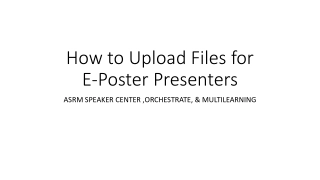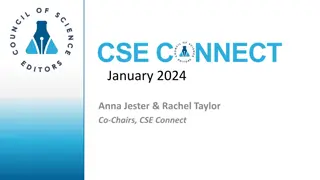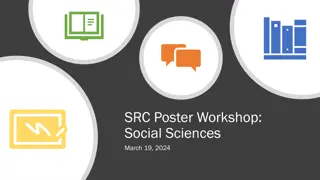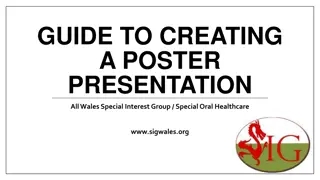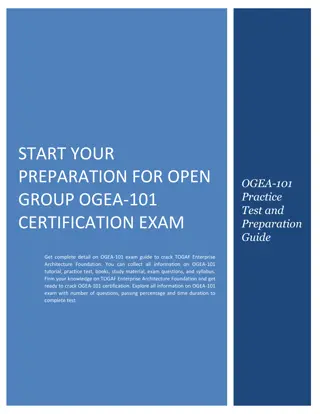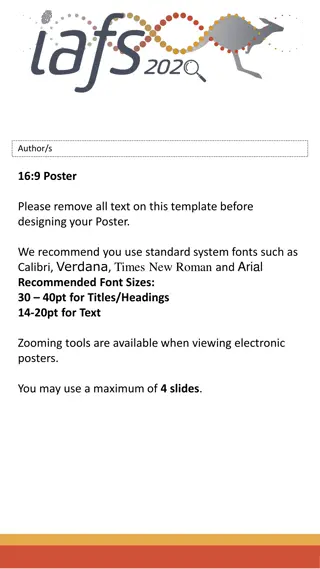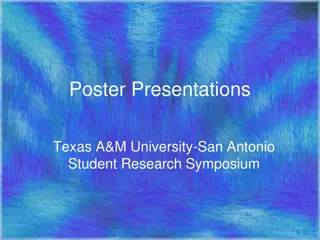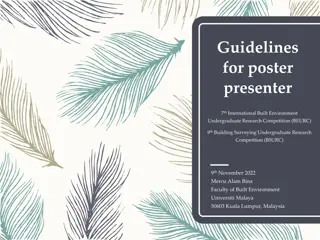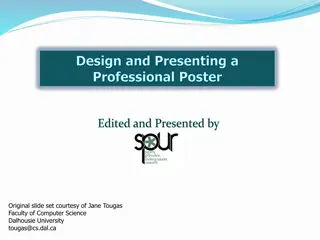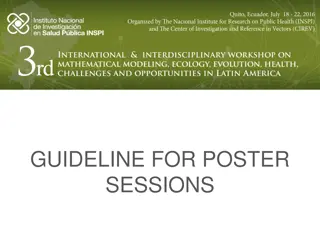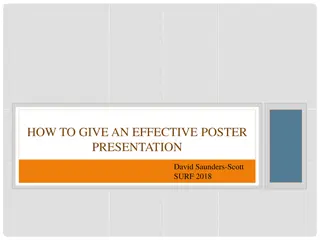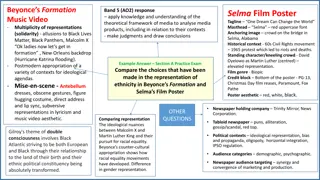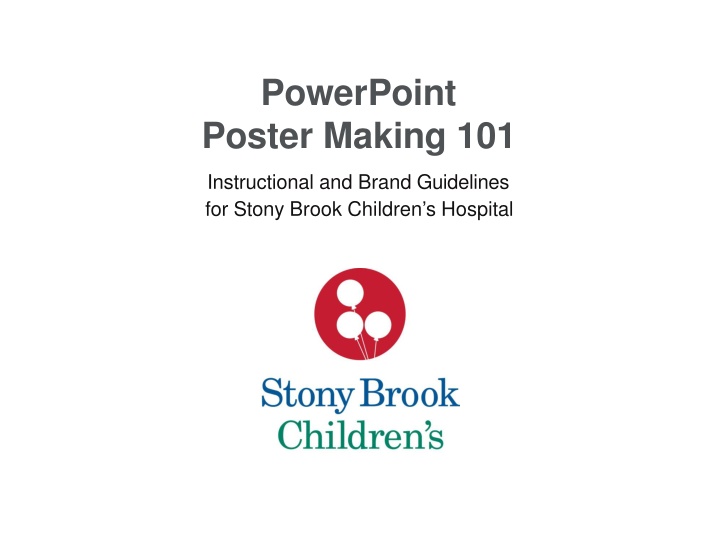
Effective Poster Design Tips for Stony Brook Children's Hospital Event
Enhance your poster presentation skills with these essential design guidelines tailored for Stony Brook Children's Hospital. Discover insights on word count, visual components, poster dimensions, layout, and key components to create a compelling and impactful poster for your event. Follow these instructions to effectively convey your message to your audience and ensure a successful presentation.
Download Presentation

Please find below an Image/Link to download the presentation.
The content on the website is provided AS IS for your information and personal use only. It may not be sold, licensed, or shared on other websites without obtaining consent from the author. If you encounter any issues during the download, it is possible that the publisher has removed the file from their server.
You are allowed to download the files provided on this website for personal or commercial use, subject to the condition that they are used lawfully. All files are the property of their respective owners.
The content on the website is provided AS IS for your information and personal use only. It may not be sold, licensed, or shared on other websites without obtaining consent from the author.
E N D
Presentation Transcript
PowerPoint Poster Making 101 Instructional and Brand Guidelines for Stony Brook Children s Hospital
Poster Considerations The following guide was designed to assist you with formatting and printing your poster presentation while using the system-wide brand guidelines of Stony Brook Children s Hospital. PowerPoint was designed to project large images in a dark room. The amount of copy, images and colors that work well for slides don t necessarily work for a poster.
Word Count: under 500 words A poster is not a paper. Apaper is constructed for independent learning. Aposter by contrast has YOU standing next to it as its guide. Your entire poster should have under 500 words total. If your poster is clear and concise, an individual should be able to read it in under 10 minutes. Always remember your target audience!
Visual Components Every image is important. Images should be legible from a distance. Clean and precise images are easy to see and understand. Use charts, graphs and tables Excel imports are common. If import problems occur, save the image in a pdf format, then import to PowerPoint. Use clear photographs and/or illustrations Save these images in a pdf or jpg format (300 dpi is recommended). For best printing results, the original photograph or illustration should be 12 wide at 300 dpi. It is not recommended to enlarge these images or to download low resolution images (72 dpi) from the Internet. Visual quality will be compromised. If the image looks blurred when imported to your poster, it will print this way as well.
Poster Dimensions PowerPoint templates provided are both horizontal 42 x 36 and vertical 36 x 42 orientations. Vertical Horizontal The paper available for printing is 42 inches. Note: Posters more than 42 inches are considerably more expensive to print.
Layout of Poster Header Title Author(s) CH Logo Logo (optional) Column 1 Column 2 Column 3 Abstract Results Conclusion Introduction Literature Cited Acknowledgements Materials and Methods
Poster Components Title: Convey the issue under study and draw passersby to your poster. Derive it from your hypothesis. Should not be greater than two lines. Introduction: Use the absolute minimum amount of background information. Set the context of your study and draw your audience in. State your hypothesis clearly. Remember, less is more Materials and Methods: Briefly describe experimental procedures, patient population, statistical analysis, etc. Section may be omitted if sufficient detail is included in figure/table legends.
Poster Components Results: Use tables and figures to present your findings. Clinical research usually begins with a flow chart describing patient recruitment and a table of demographics for subjects included in the analysis. Conclusions: Restate the significant findings of your study and the relevance of the results. Affirm or reject your original hypothesis. Discuss future directions. Literature cited: Stick to one bibliography format for all listed references. Limit the bibliography to a maximum of 10 references. +/-Acknowledgments: Include the names of all people who helped with the work but were not included as authors. List sources of funding. Include a conflict of interest statement.
Getting Ready Draw a rough draft of your poster s components.
Download a Poster T emplate The poster template choices for Stony Brook Children s Hospital are: SBCH 2015_VerticalT emplateOptions.potx and SBCH 2015_VerticalT emplateOptions.potx
Choose a Poster T emplate Choose one layout template Delete all remaining pages when ready If you need to add a slide, in the upper left corner of the document ribbon, Go to Home, New Slide, click and hold the drop-down arrow to the right of the (New Slide) icon. Note: If you do not see the icon, click on the Home tab in the ribbon.
SBCH Color Palette Correct usage of the Stony Brook Children s Hospital Graphic Standards Color Palette is vital for brand consistency. Primary Colors Secondary Colors T ertiary Colors Pantone Black Pantone Pantone Pantone Pantone 187 7709 Cool Gray 9 584 7652 Do not recreate or add to the Theme Color Palette.
SBCH Theme Colors Theme Colors have been set-up for you to use within PowerPoint and Excel. Go to the Ribbon s Home Tab, Format and click on the paint bucket icon. Ribbon Theme Color Palette
Theme Color Palette Percentages You are encouraged to use the Theme Color Palette with color percentages for charts, graphs and tables not text. Primary Colors Secondary Colors T ertiary Colors Black Pantone 7709 Pantone Cool Gray 9 Pantone 584 Pantone 7652 Do Not Screen Pantone 187 Do not recreate or add to the Theme Color Palette.
RGB Color Palette The RGB Color Palette breakdowns listed below are for those using statistical software programs other than Excel. Primary Colors Secondary Colors T ertiary Colors Pantone Black Pantone Pantone Pantone Pantone 187 7709 Cool Gray 9 584 7652 RGB RGB RGB RGB RGB 184-18-55 105-108-116 214-220-41 240-78-37 46-191-202 Please note: Use the SBCH color palette in this guide for all other software programs (Excel, PowerPoint, Word, etc.)
Font Recommendation Helvetica (Only Helvetica)
Font Color Options The font Helvetica color choices are: Black, Red and White. Choose only from the Theme Color Palette options. White White White
Font: Helvetica Brand consistency is key. Only use the font Helvetica. Use Regular, Italic, Bold, Bold Italic, CAPS regular and CAPS BOLD.
Replace Fonts to Helvetica If your PowerPoint T emplate does not say Helvetica go to: Format (drop-down menu), Replace Fonts, With: Helvetica, Replace.
Font Sizes 1. 2. 3. 4. 5. Title: 85 point Author(s): 54 point Sub-Headings: 36 point Body text: 24 point Captions: 18 point T o be legible 14 feet use 72 pt. T o be legible 12 feet use 60 pt. T o be legible 10 feet use 48 pt. T o be legible 6 feet use 30 pt. 1 2 3 5 4
Colors: Can you read me now? Can you read me now? Can you read me now? Can you read me now? Can you read me now? Can you read me now? Can you read me now?
Working in Excel Apply the SBCH Theme Color Palette to Excel charts, graphs and tables: Double click on the Home tab, Themes, Colors and choose Custom.
Working in Excel Easily apply your own colors to this template. This template is formatted using themes that enable you to apply fonts, colors and graphic formatting effects throughout the workbook with just a click. An Excel file has been supplied for reference. Budget Summary Projected Monthly Income Income 1 Income 2 Extra income Total income Projected Monthly Expenses $6,000 $1,000 $2,500 $9,500 #REF! Actual Monthly Income Income 1 Income 2 Extra income Total income Actual Monthly Expenses $5,800 $2,000 $1,500 $9,300 #REF! Select Themes on the Home tab. File name: SBCH_Excel Poster Sample.xlsx Balance (income - expenses) Projected Balance Actual Balance Difference Choose the four-square icon on the right and click on Custom SBCH color palette1. #REF! #REF! #REF! Expense Overview Budget Categories Values Total Cost % of Expense 25.93% Food Groceries Dining Out Transportation Housing Insurance Gifts and Charity Personal Care Entertainment Loans Pets Children Taxes Savings or Investments Grand Total $1,200 $0 0.00% 25.93% 18.37% 18.15% 17.29% 15.13% 3.03% 2.12% 0.00% 0.00% 0.00% 0.00% 0.00% 100.00% Food $1,200 $850 $840 $800 $700 $140 $98 Groceries Dining Out Transportation Housing Insurance Gifts and Charity Personal Care $4,628 Entertainment Loans Pets Children Excel file example
Edit Charts, Graphs and T ables You can adapt the color and font format theme within PowerPoint for your Excel charts, graphs and tables. There are two options: Double click on the Chart, Graph or T able Choose Edit Existing or Convert
What is Edit Existing and Convert? Edit Existing: Allows you to modify an original Excel file. Convert: Allows you to convert the original Excel file to PowerPoint s theme and color palette options. Chart example
Convert Images with Fill Color Custom color Converted images: Click on the inner image. The section will be highlighted. Go to Fill Color (paint bucket icon). Choose an Accent Color from the Theme Colors palette. Chart example
Convert Images with Chart Styles Custom color Converted images: Click on the graph. The section will be highlighted. Go to Chart Layout, Format, Chart Styles. Choose a chart style from the SBCH Theme Color Palette. Chart example
Charts Charts should be LARGE and as simple as possible. Always use a 3 point, gray rule outer box with a white background. Use black text. Bad Good Chart example
Graphs Graphs should be LARGE and as simple as possible. Use black text. Always use a 3 point, gray rule outer box with a white background. Bad Good Mouse 119 (Both Flanks: SK (Job) LCL concentrated) Tumor Development and Regression Tumor size (mm 290 300 Tumor size (mm 150 270 squared) 250 230 squared) 210 190 100 170 150 Le. 130 Le. 110 50 890 fl a n k 670 fl a n k 450 230 Right Flank 10 0 Right Flank 0 20 40 60 80 0510 15 20 25 30 35 40 45 50 55 60 65 70 75 80 Days Post-Injection Days Post-Injection Graph example
Figures Be sure to include a brief caption for your figures, and explicitly refer to the figure in the text. When adding an image to your poster, use a 3 point, gray rule border with a white background. This will give the image a clean framed look. All text associated with a figure image must be in black. Black text within figures reads best from a distance.
How to Crop an Image Using the crop tool will not distort (stretch or elongate) your image. Highlight the image, go to the Ribbon area, Format Picture, Crop. Photo example
As Youre Putting It All Together EMPTY PHRASE a majority of a number of accounted for by the fact that as a consequence of due to the fact that in view of the fact that for the reason that on account of on the basis of on the grounds that owing to the fact that EQUIVALENT most many because Tips for Good Writing 1. Create sentences that use carefully chosen subjects and vigorous verbs to express your central meaning. an order of magnitude are of the same opinion at the present (moment) at this point in time by means of despite the fact that during the course of fewer in number for the purpose of has the capability of having regard to if conditions are such that in all cases in close proximity to in connection with in my opinion it is not an unjustifiable assumption that in order to in the event that it is clear that it is often the case that it is possible that the cause is it is worth pointing out that it may, however, be noted that lacked the ability to large numbers of prior to ten times agree now 2. Omit needless words and empty phrases. 3. Use definite, specific, and concrete language, avoiding overuse of abstractions and technical jargon (including abbreviations). by, with although during, while fewer for can about if always, invariably near about, concerning I think 4. Use the active voice and active constructions as much as possible. 5. Keep related words together. Subjects should be close to their verbs, and modifiers close to the words they modify. 6.Express coordinated ideas in a similar form. Parallels in meaning are reinforced by parallels in structure. to if clearly often the cause may be note that but could not many before Taken from Constance Baldwin workshop (2018) The Nuts and Bolts of Scientific Writing
Getting Your Poster Printed Institute for STEM Education (I-STEM) Format posters as Powerpoint slides: 42w x 36h inches Acceptable formats are PowerPoint and PDF Mac users, please save as pdf if possible Posters will only be accepted via email (NOT flash drives). Email file to: posterprinting@stonybrook.edu You do not have to pay for printing. Your name will be on a list of approved submissions Indicate to I-STEM staff that you are part of Stony Brook Pediatrics when you submit file for printing. For Poster Formatting Instructions, go to: https://www.stonybrook.edu/istem/poster_printing_services/index.php Location of I-Stem: In the Life Sciences Building basement level, Room 092 (to the left when you go down the stairs or elevator from the lobby).
Timeline to Research Day April 17 Poster Workshop April 24 Two Minute Talk Workshop (10 11 am) May 10 Send draft of poster to: Your Mentor Your RSOC Liaison (MJE) May 15 Receive and incorporate edits Get okay from your Mentor before printing May 20-24 Poster printing at I-STEM (Email file) May 28 All posters dropped off at T-11-069 (MJE Lab) May 29 Research Day - Present poster to judging panel
What to Expect Based on 2018 Research Day 8:00 8:30 8:30 REGISTRATIONAND BREAKFAST Theater Lobby WELCOME - Dr. Margaret Parker CHAIR S OPENING REMARKs - Dr. Carolyn Milana Main Theater KEYNOTE ADDRESS Main Theater INTRODUCTIONOF KEYNOTE SPEAKER Dr. Andrew Lane KEYNOTE SPEAKER:SUSAN FURTH, MD, PHD Lessons Learned from the Chronic Kidney Disease in ChildrenCohort Study 8:40 8:45 9:35 PLATFORM PRESENTATIONS Main Theater SESSION 1 (9:40-10:10) 9:40 9:45 -10:10 INTRODUCTIONOF INVITED JUDGES Dr. Robert Parker RESIDENTS PLATFORM PRESENTATIONS(Chair Dr. Robert Woroniecki) JOSEPH CAFONE, MD US Adult University Rheumatologists Preferences and Knowledge Gaps Regarding the Care of Young Adults with Rheumatic Conditions KATHLEEN MURPHY, DO Rates of Blood Lead Screening and Barriers to Compliance in Stony Brook Primary Care Pediatric Offices COFFEE BREAK - Theater Lobby 10:15 10:30 SESSION 2 (10:35 11:20) 10:35- 10:50 PEDS TALKS (Introduced by Dr. Marian Evinger) DANIELA FEITOSA, MD What Were We Thinking? JENNIFER LUTZ CIFUNI, DO Dr. Patient: A Warrior 10:55 11:20 FELLOWS PLATFORM PRESENTATIONS(Chair Dr. Janet Fischel) ADERONKE ADEFISAYO, MD Reception & Barriers to Long Acting Injectable Antiretrovirals (LA-ARV) for Pre-Exposure Prophylaxis (PrEP) in Adolescents LAURA STABIN, MD Regional Tissue Oxygenation in Term Infants with Presumed Sepsis 11:20 12:15 12:20 1:00 POSTER SESSION - Theater Lobby (Chair - Dr. Taly Glaubach) LUNCH Zodiac Gallery -Dr. Furth to discuss her academic career path Presentation of Awards and Closing Remarks by Dr. Milana Invited Judges plus Drs. Glaubach and Woroniecki
This is how it all sorts out. RESIDENT POSTER PRESENTATIONS 1 2 3 4 5 Poor Average Good Excellent Outstanding TOPIC Importance of Topic Hypoth.- Driven Methodol. Sound Meaningful Results Conveys Implications Speaker Presence Fielding Questions TOTAL SCORE Comments RESIDENTS TEAM A J. Dunahay, MD, PGY-3 Changes in Growth Trajectory Z Scores Predict VLBW Growth Outcomes Obesity Ident. & Mgt in the Outpatient Setting Improving High- Risk Clinic Compliance Attrition Factors in Ped. Wt. Mgt. Ctr. Parents Perspect. Riboflavin Transporter Deficiency (CR) S. Heathcote, MD, PGY-3 K. Louie, MD, PGY-3 N. Shin, DO, PGY-3 D. Feitosa, MD, PGY-2
Best of Luck! StonyBrook Children's

